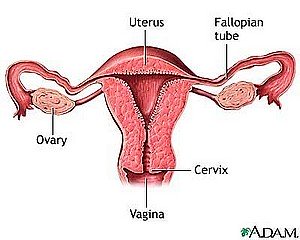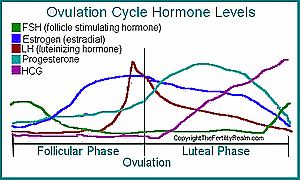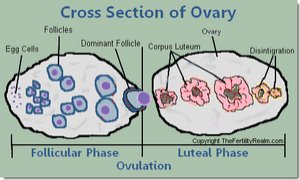What is the Luteal Phase?
What is the Average Length?
The luteal phase is the second half of your menstrual cycle. It starts the day after ovulation and ends the day before you get your menstruation period. The length is usually consistent each cycle.
Recommended:
The average luteal phase length is typically 14 days long. But normal ranges are from 10 to 16 days in length. If it is shorter than 10 days then you may have a luteal phase defect.
The average 14 days is where the two week part of two week wait (2WW) comes from. The 2 week wait is another term used to describe this phase. The wait part describes what you do during this time period before you can determine if you are pregnant or not.
Get more information on Vitex Liquid Extract for luteal phase support.
Once you have detected your ovulation period by observing your signs, such as cervical mucus changes, or using an ovulation predictor kit, or fertility monitor, etc., then the day after you ovulate is the day the luteal phase starts.
The day after you ovulate is counted as 1 day past ovulation (DPO), the next day is 2 DPO, and so forth.
Once the egg or ovum has been expelled from the dominant follicle from within the ovary, the follicle remains and goes through changes to become what is now called the corpus luteum. That is where the term luteal phase comes from. These changes begin with the surge of luteinizing hormone (LH) just before ovulation. And under this influence is what causes the change from dominant follicle to corpus luteum.
Get more information on OvarianWise Egg Health Kit to support ovary and egg health.
The corpus luteum continues to produce hormones that are necessary for conception and pregnancy.
It continues to produce estrogen, although in lower levels than previously in the follicular phase, which is the first half of your ovulation cycles or pre-ovulatory phase.
The continued production of estrogen is necessary for the continued development or thickening of the endometrium or the endometrial lining of the uterus.
Get more information on the EndoWise Fertility Kit for support of the endometrium.
The corpus luteum also continues to produce progesterone. Progesterone levels are much higher in the this phase, as opposed to the follicular phase. Progesterone is necessary for preparation of the endometrial lining. It readies the uterus for implantation so that the fertilized egg can be nourished with blood supply within the lining. Progesterone creams can be an efficient way to increase progesterone levels during the luteal phase.

After the egg leaves the ovary it is then swept up into the fallopian tube where it meets sperm to be fertilized (or not, if you haven't timed intercourse or you are not trying to become pregnant). This is the actual moment of conception.
Get more information on the FallopianWise Fertility Kit for support of the fallopian tubes
If an egg becomes fertilized, it then travels down to the uterus where it implants or burrows in and attaches itself to the lining of the uterus. This is where the tiny embryo begins to grow and develop.
Once pregnancy implantation takes place, the embryo begins to produce a hormone called human chorionic gonadotropin (hGC) the pregnancy hormone. This is the hormone detected by pregnancy tests. It takes about 10 to 14 days after you ovulate for hGC to reach levels that can be picked up by pregnancy tests. Another reason for the term two week wait.
The corpus luteum detects hGC hormone and continues to produce the hormones necessary for the continued growth of your baby and to sustain your pregnancy until the placenta can take over production.
If an egg does not become fertilized, then it quickly begins to die and to be absorbed into your body to be eliminated.
HCG is then not detected by the corpus luteum within the allotted time at the end of the luteal phase and will begin to degenerate and die off. Thus drastically lowing the production of progesterone and estrogen.
This drop in hormones, most notably the drop in progesterone levels, signals the endometrial lining of the uterus to break up and be flushed out and signifies the end of the luteal phase. This emptying of the contents of the uterus obviously is your menstrual period. And your ovulation cycle starts all over again.
Get more information on the Harmonize Fertility Formula to support hormonal balance.
If the luteal phase length is not long enough (10 to 16 days) then implantation cannot take place. The corpus luteum starts to break down too soon and hormone levels drop and your period begins before implantation can take place. If you have a short luteal phase (less than 10 days) then you may have a luteal phase defect.
If the luteal phase length is longer (long luteal phase) of about 16 days then this is perfectly ok. As this give the embryo plenty enough time to implant. And indicates that your eggs and follicles (and then corpus luteum) are all strong and healthy. As long as you know that your are ovulating, a long luteal phase shouldn't be a problem.
Related pages
Luteal Phase Defect | When Does Ovulation Occur? | What Happens at Conception? | When Does Conception Occur? | When Does Implantation Occur? | Two Week Wait | Ovarian Follicles | Corpus Luteum | Pregnancy Implantation | Basal Body Temperature | Basal Body Thermometer | Endometrium | Fallopian Tube |
The Fertility Realm ??? Ovulation Cycle ??? Luteal Phase
The Fertility Realm ??? Luteal Phase





Have your say about what you just read! Leave me a comment in the box below.